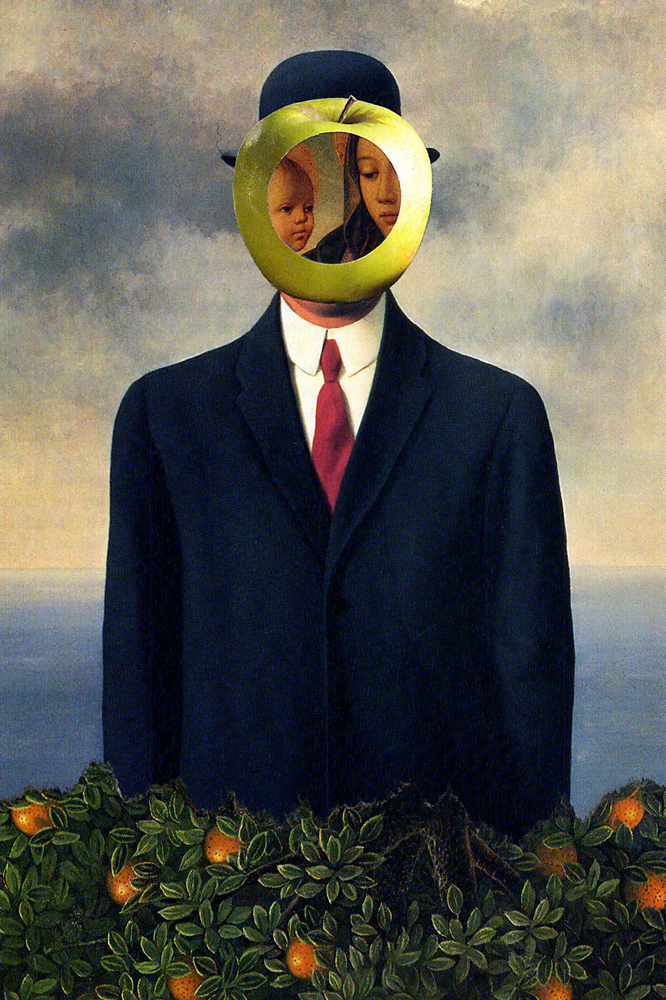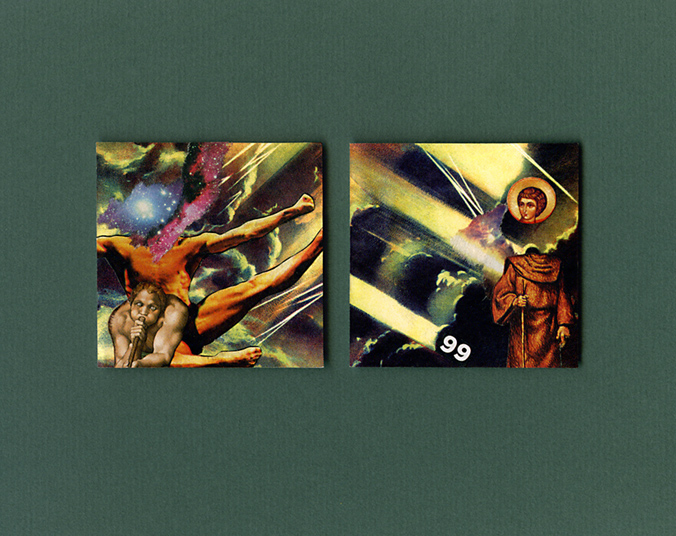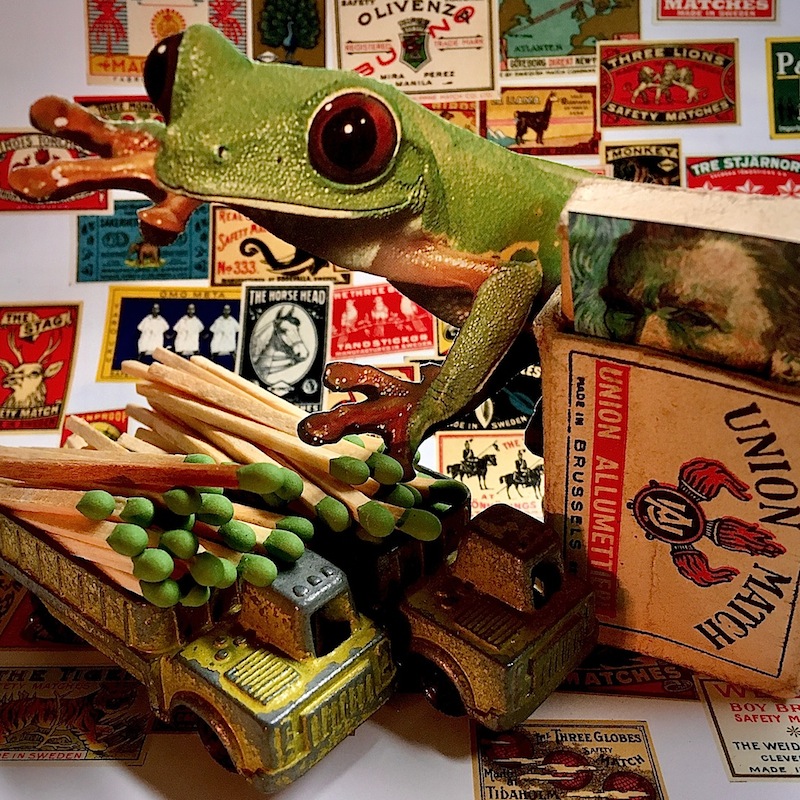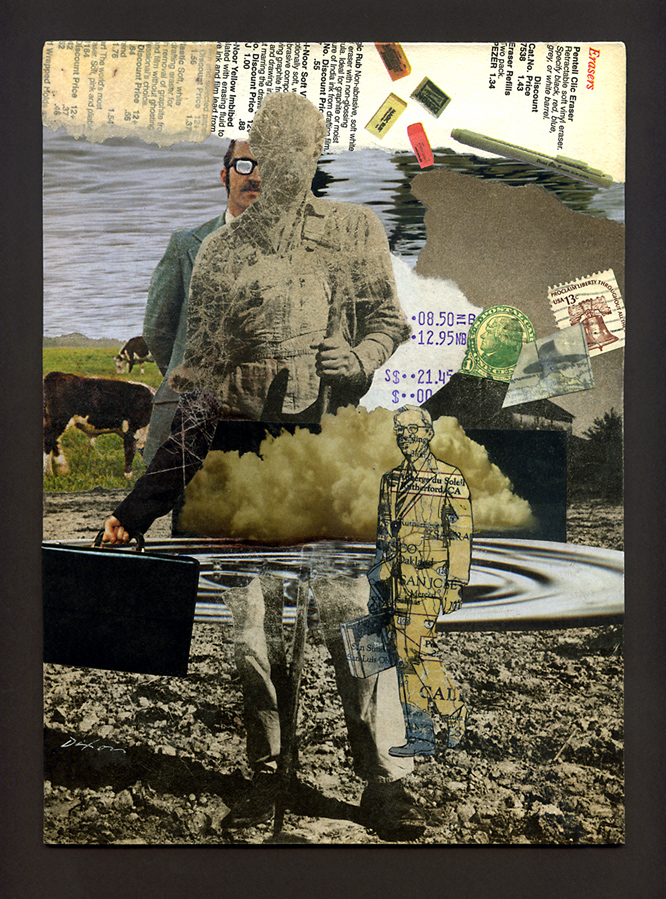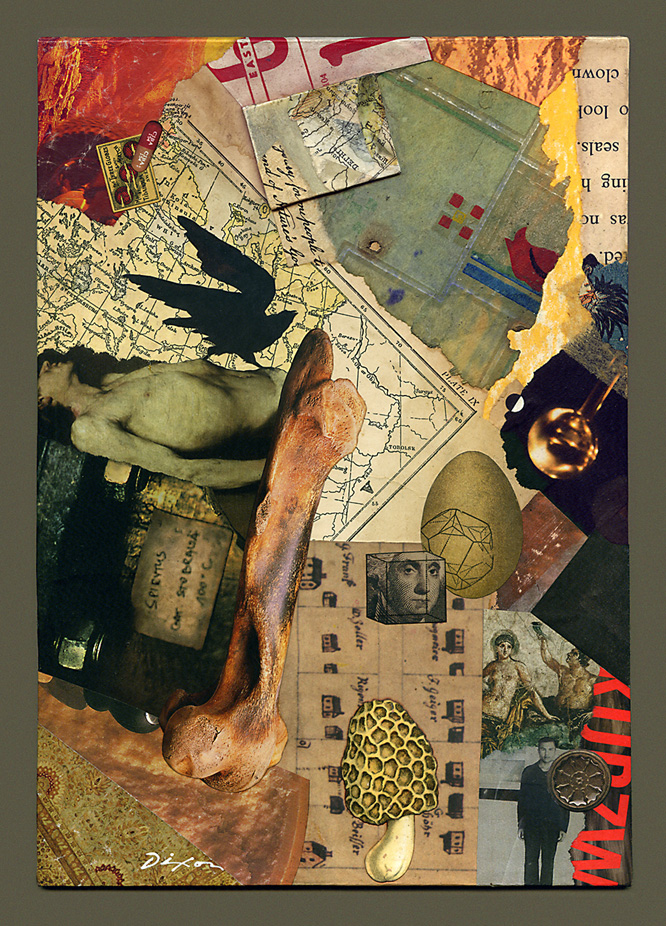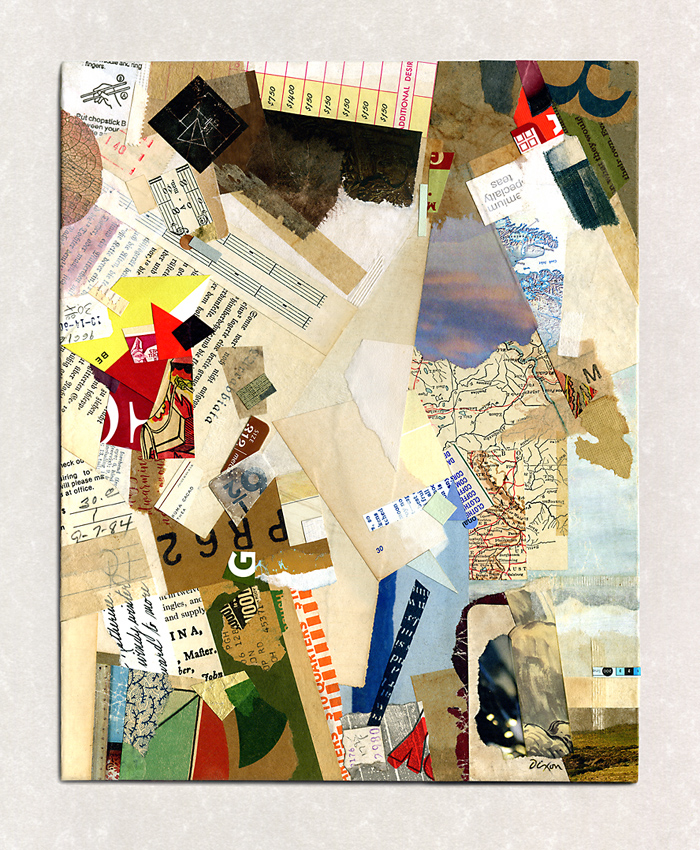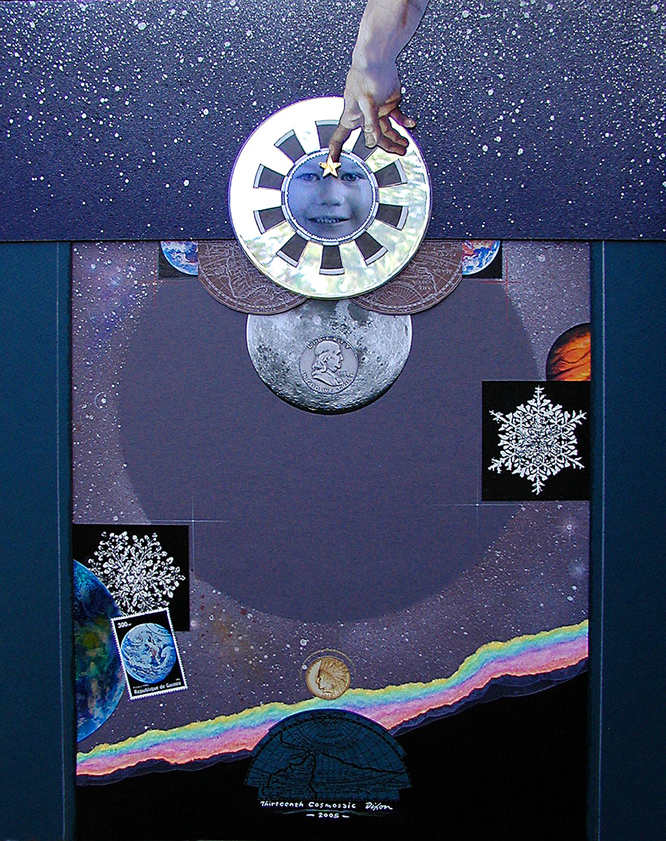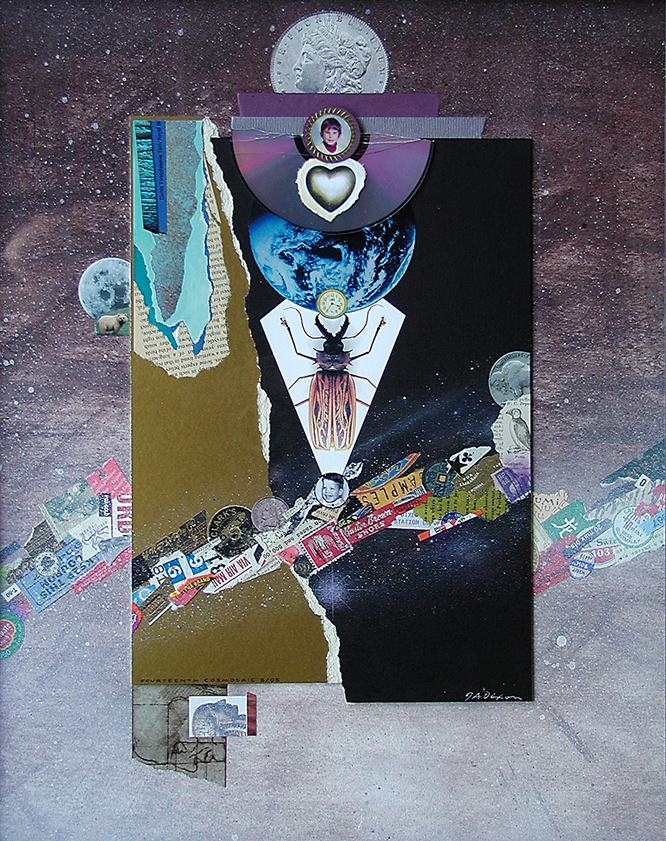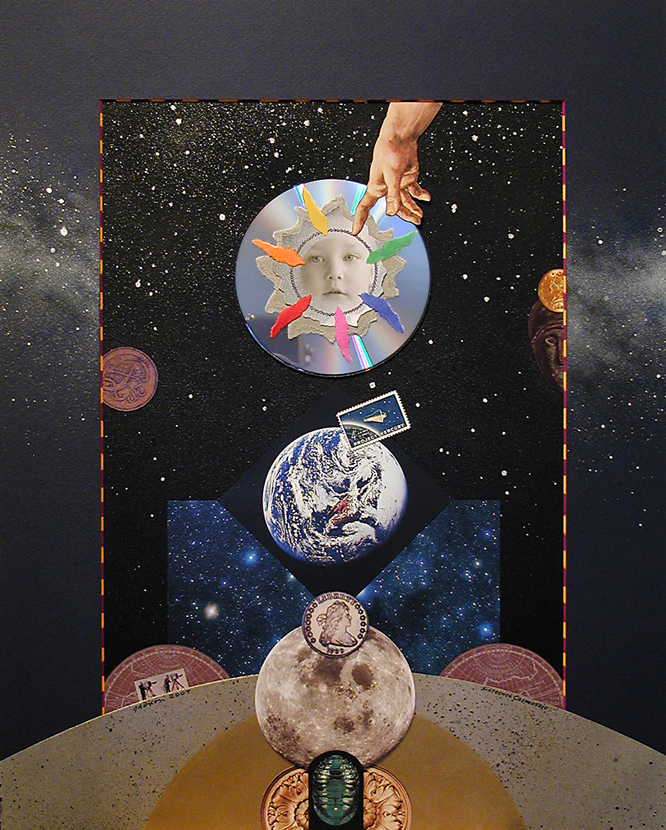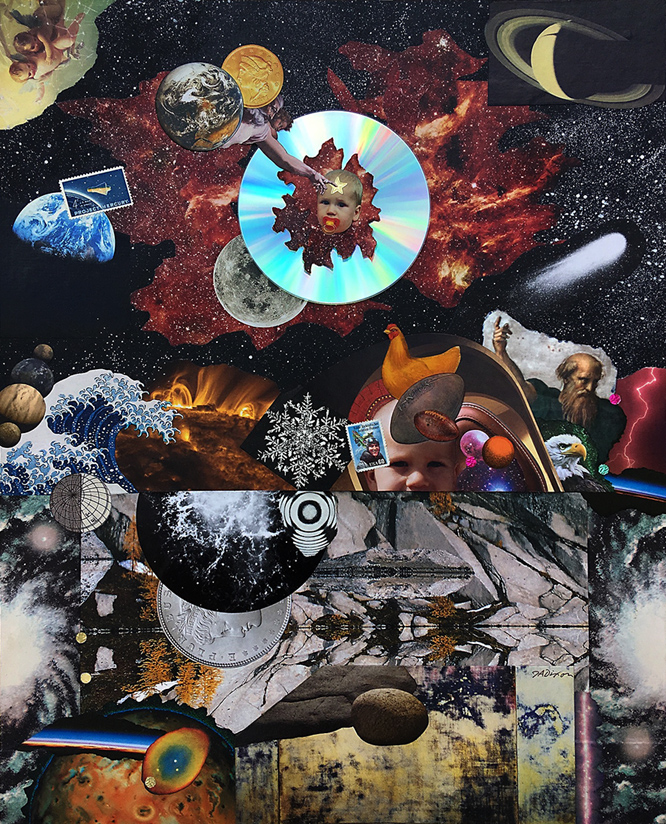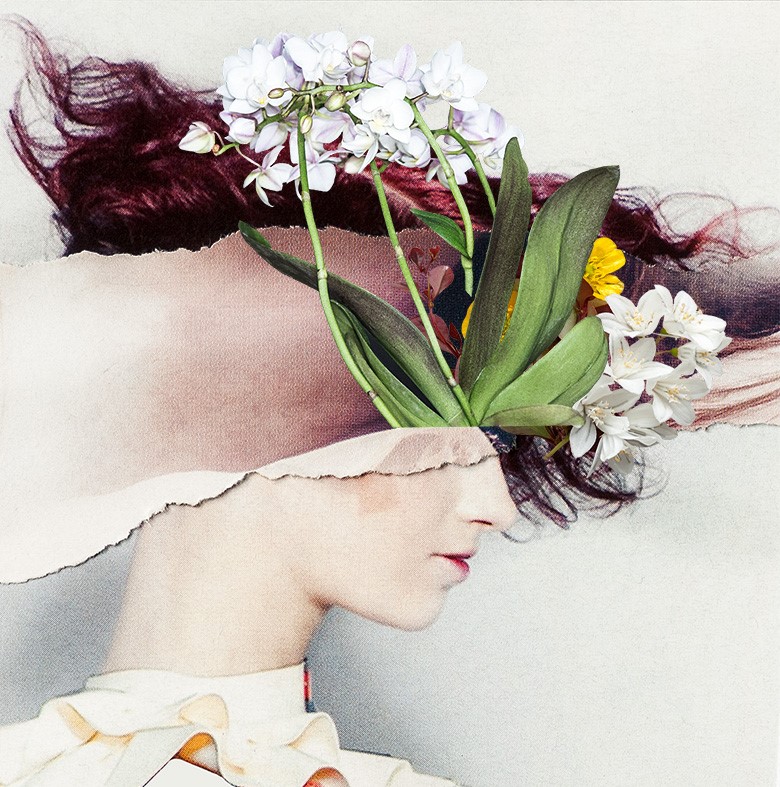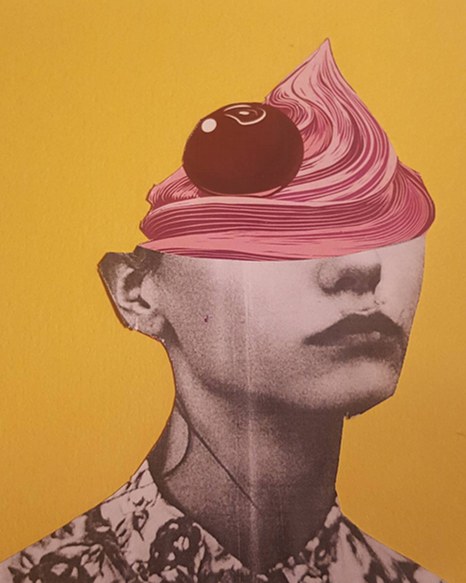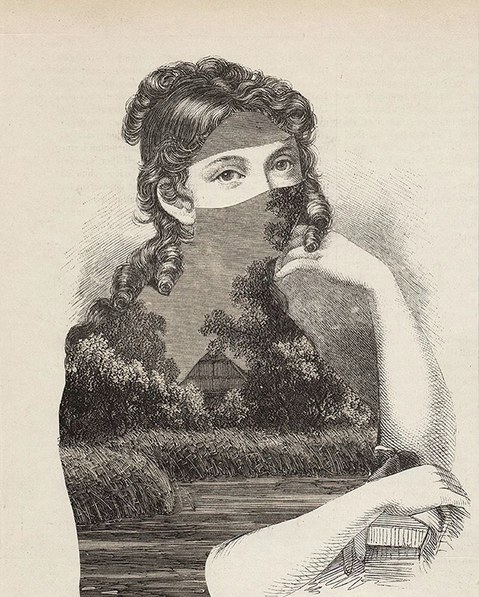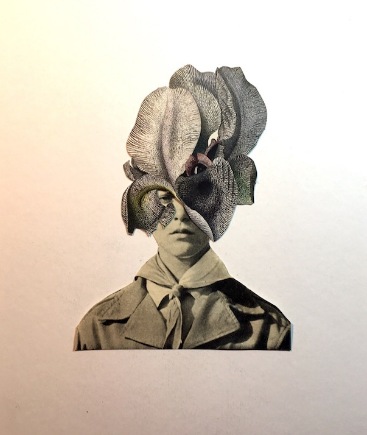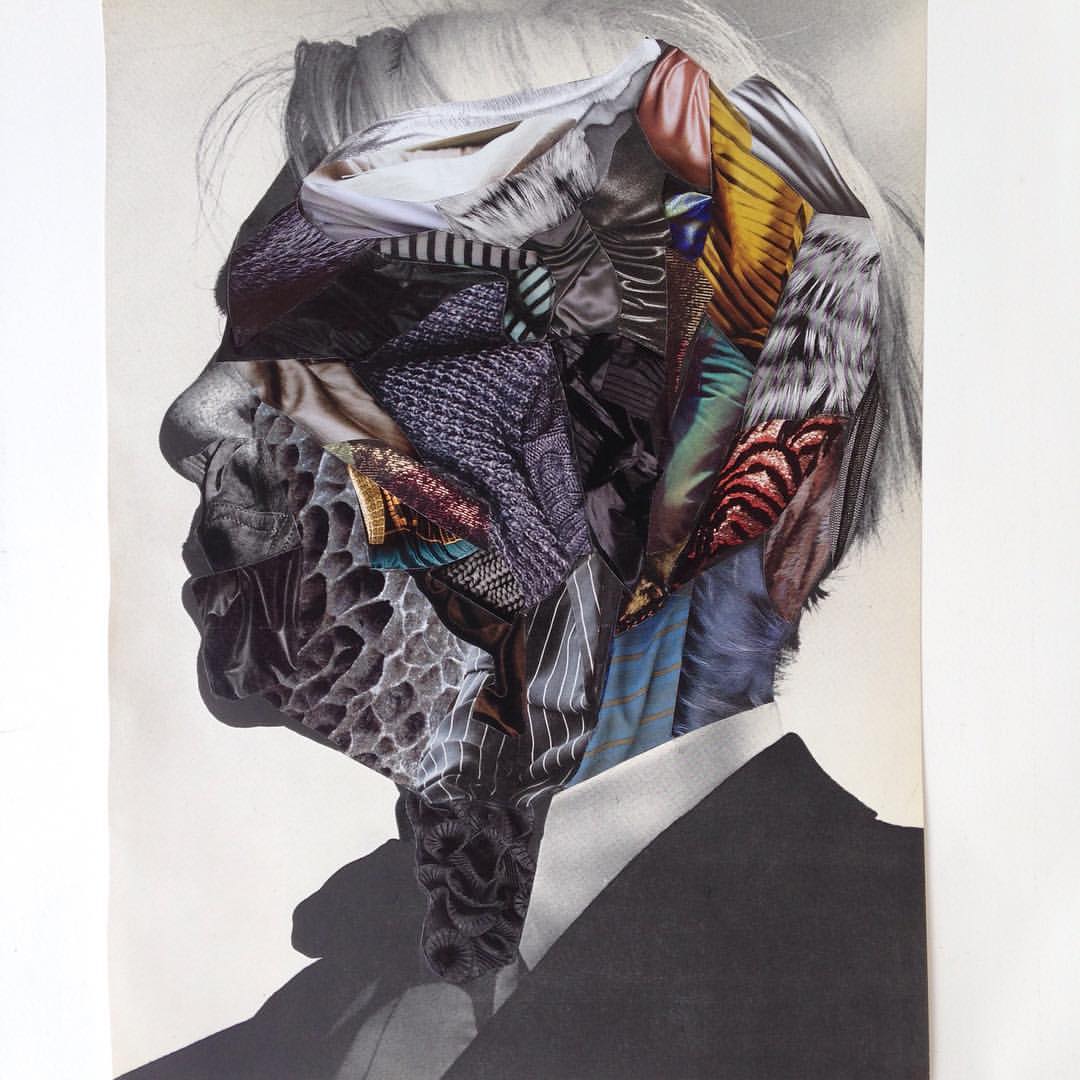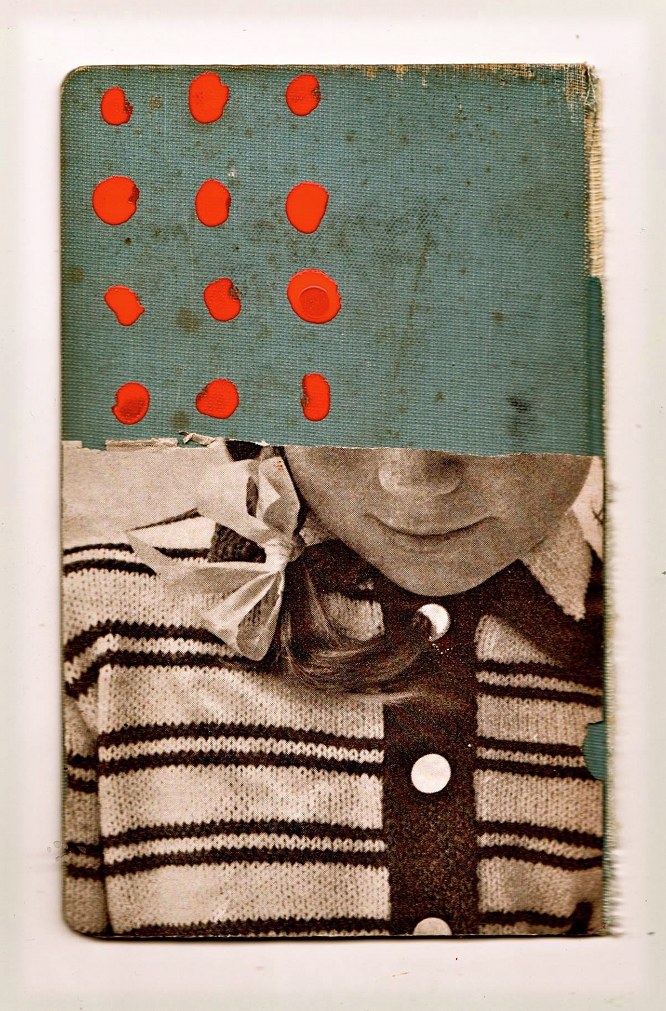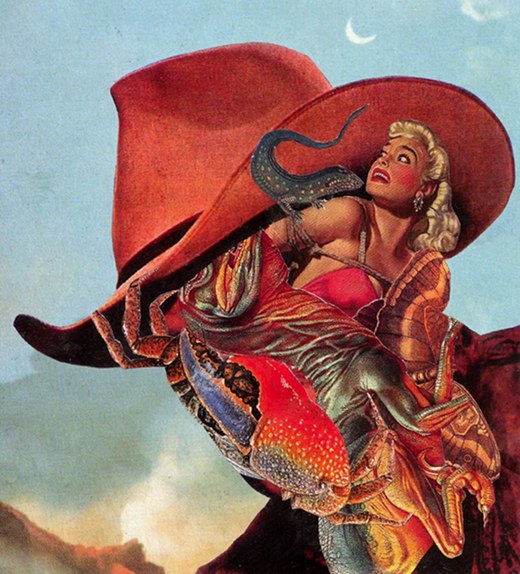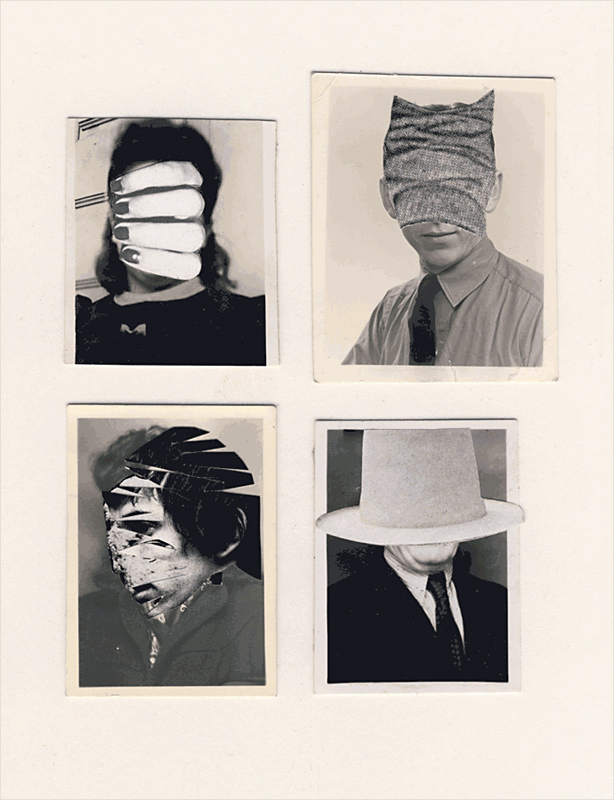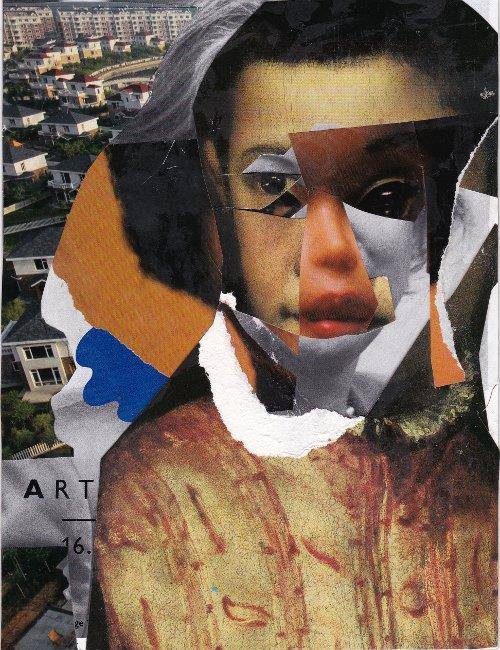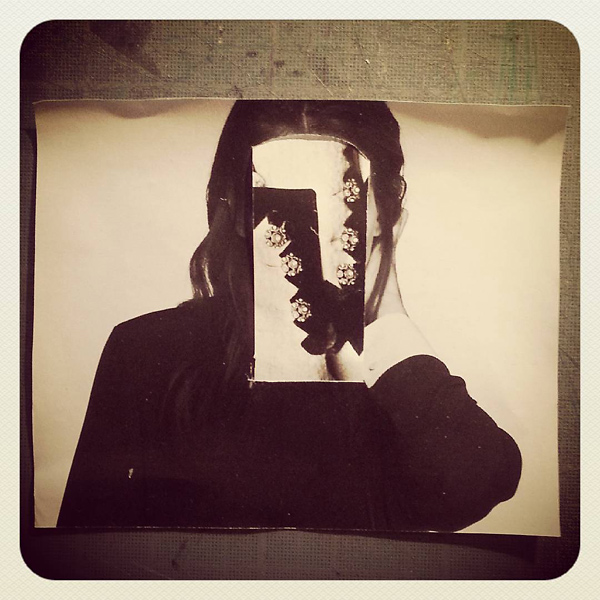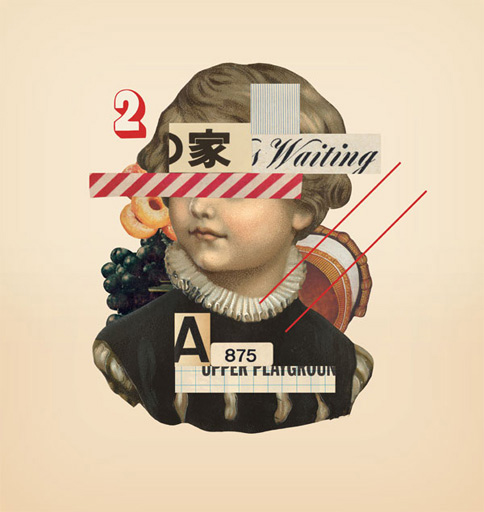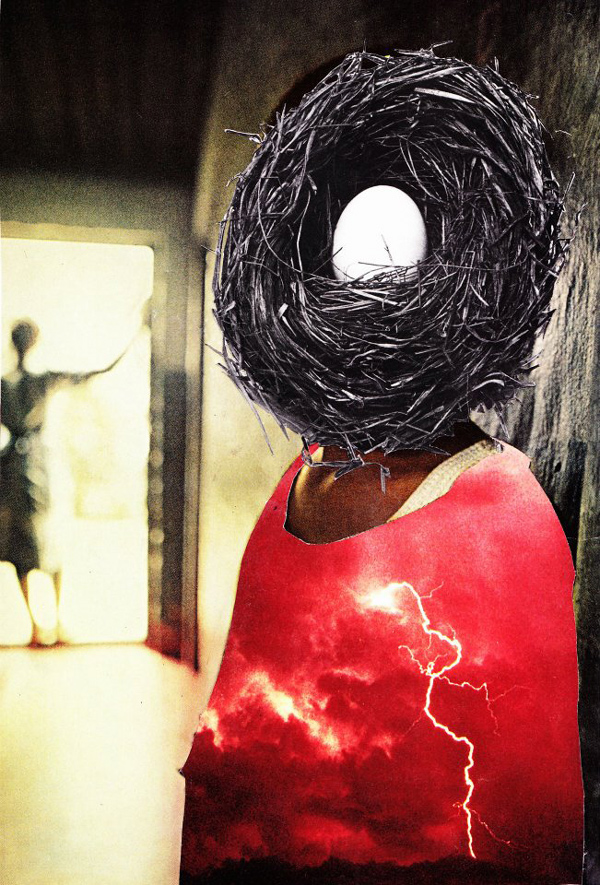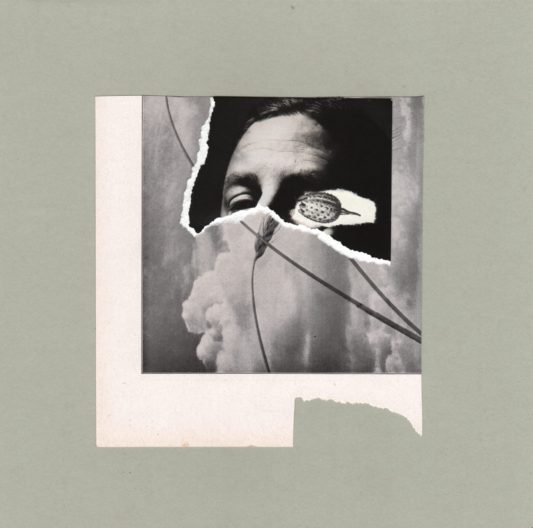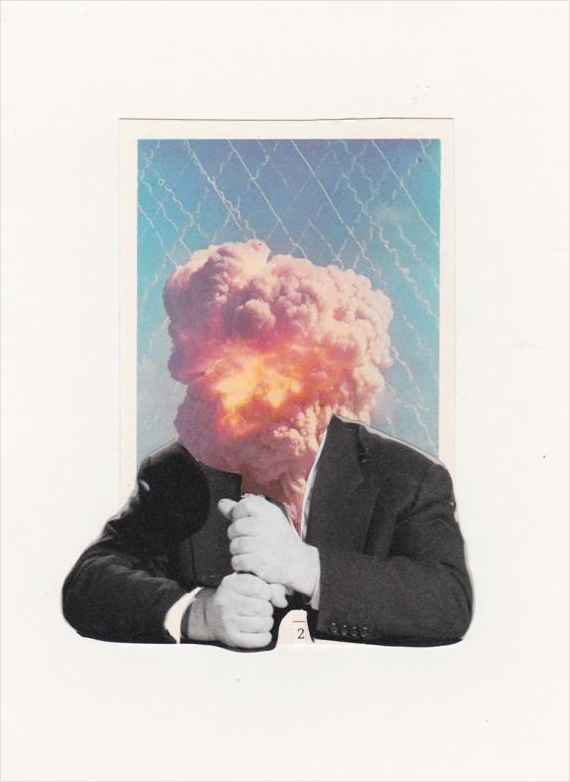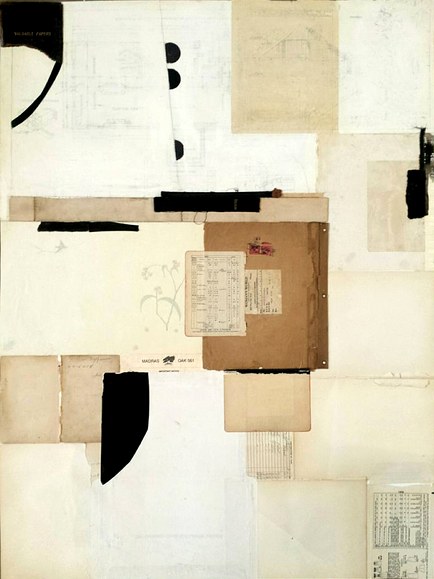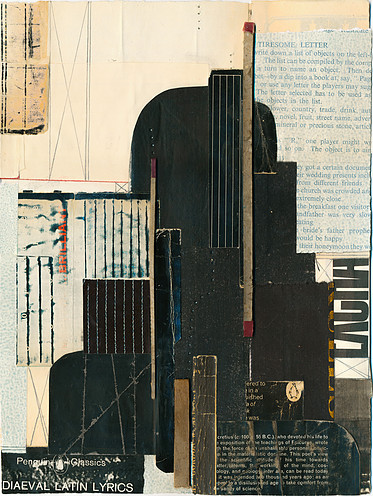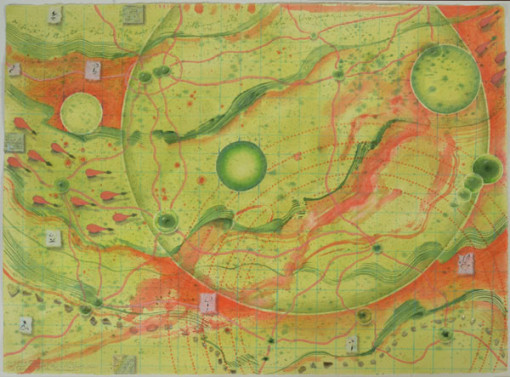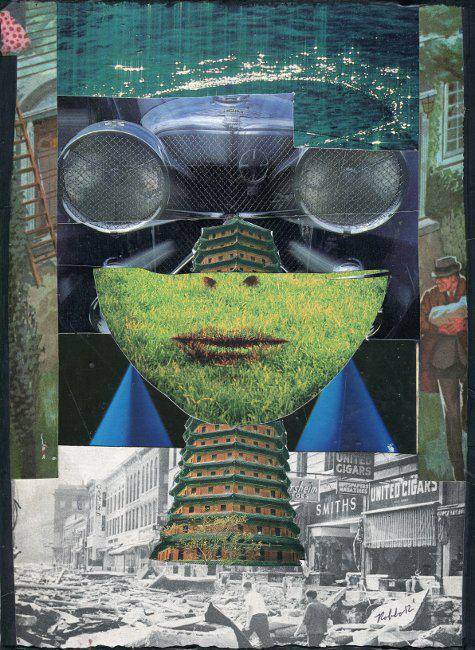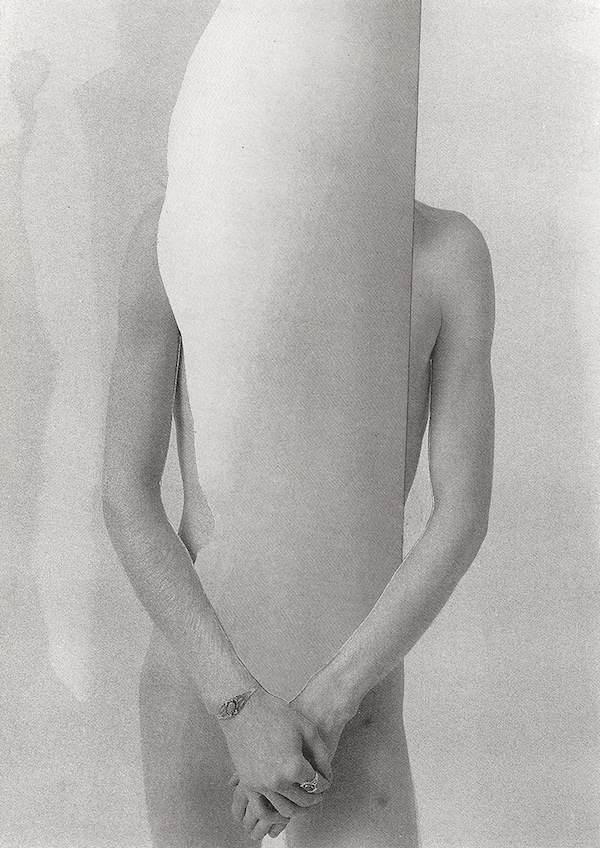Natal Homage
collage greeting by J A Dixon
private collection
Archive for the ‘Surrealism’ Category
The surreal meaning of Christmas
Friday, December 25th, 2020Forgot to Blow My Mind (diptych 99)
Tuesday, July 28th, 2020Forgot to Blow My Mind (diptych 99)
collage miniatures by J A Dixon
2 x 2 inches each
left square | right square
available for purchase
< back to the comprehensive page of collage diptychs
Strike a light!
Sunday, May 31st, 2020“Edinburgh Collage Collective would like to send a huge thank you to all the participating collage artists from around the world who have joined us for this project. Our matchbox project has attracted over 1000 submissions. It’s been a great pleasure and inspiration to receive and share all the incredible work. We have certainly seen examples of artists thinking both inside and outside the box. The exploration of the medium has resulted in a wide variety of diverse approaches and interpretations. We have seen everything from 2d flattened boxes to full blown dioramas – all taking their inspiration from the humble matchbox.”
— Rhed Fawell, E C C
I was inspired to compose something different for the “STRIKE A LIGHT” Matchbox Project, an open call from Edinburgh Collage Collective, which invited international collage artists to make work incorporating the matchbox as a visual starting point. It was a fun submission for me, since I rarely explore 3D collage.
The two shuttle trucks by Tootsie Toy® are from 1967. The original Union Match box (with Vincent peeking out) is one I brought back from Brussels in 1974. The whole thing was sparked by finding a tree frog.
Better not ask me to explain how my mind works. I’m still as baffled by creativity as I was when I decided, as an adolescent, that there was no possible aspiration for me other than to become a visual artist.
Strike a Light
photo-collage by J A Dixon
created for the #strikealight2020 project
Februllage ~ day twenty-two
Saturday, February 22nd, 2020Materiality
collage miniature by J A Dixon
7.25 x 10 inches
available for purchase
for Februllage 2020
Therapeutic factionalism or personal catharsis?
Tuesday, August 6th, 2019“Anger is a very limiting emotion. There’s not much you can do with it. There’s no hope in it.”
— Wendell Berry
There was a time when the arts may have held the capacity to alter the world around us. From time to time, music probably has. Perhaps the dramatic arts, too. The oral and written arts of language certainly have, and they remain highly consequential, but the notion that those engaged in artistic “visual statements” can affect society is an illusion. The early 20th-century avant-garde believed they could, and maybe they did to some limited extent, while the attention of a less distracted elite was seized. At any rate, this innovative class took what they had absorbed, rejected much of it, and cultivated the vocabulary of the modern art forms which influence the bulk of what artists do today. And almost all of what we do now has very little if any catalytic effect on evolving civilization — especially if it was overtly intended to do just that. But make no mistake about it, “message art” has been, is, and can be a significant catharsis for creative individuals. Rest assured that it will reinforce solidarity among people of like mind. It can also be relied upon to irritate many of the others.
Taboo Faction
collage catharsis by J A Dixon
8.125 x 11.5 inches
Purchase this artwork.
Precursors have precursors
Tuesday, August 21st, 2018“We do not analyze works of art because we want to imitate them or because we distrust them.”
— Paul Klee
The other day the world learned about an unpublished Ernest Hemingway short story. If there had not been a Mark Twain first, would literature know Hemingway’s writings at all? Could there have been an Isaac Asimov, Stan Lee, or Gene Wolfe without a Verne or Burroughs? The J.K. Rowling body of work without an Austen or Tolkien? 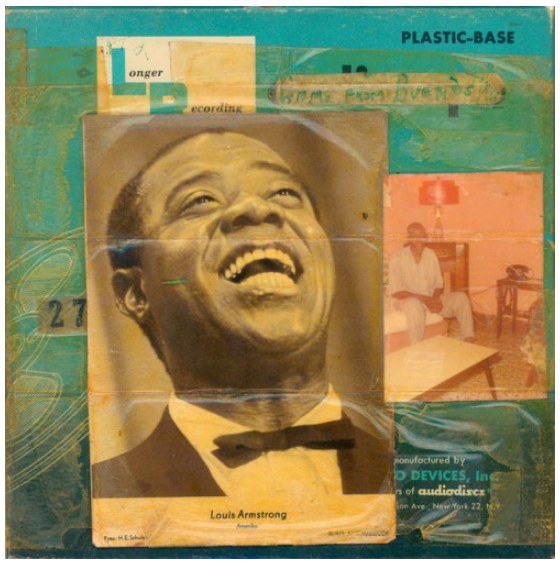 Similarly, all of today’s rock music can be linked to direct influences — to bands such as Ramones, Led Zeppelin or the Beatles, which, of course, had their own precursors. Would jazz exist in its current form without the innovations of Armstrong and all those who inspired him? Imagine a contemporary musician saying, “I really haven’t paid attention to any music that was recorded before I started to play.” And yet, not infrequently, collage artists will boast that they have little use for art history (all the breakthroughs of bygone creators who dug the swimming pools in which they now frolic).
Similarly, all of today’s rock music can be linked to direct influences — to bands such as Ramones, Led Zeppelin or the Beatles, which, of course, had their own precursors. Would jazz exist in its current form without the innovations of Armstrong and all those who inspired him? Imagine a contemporary musician saying, “I really haven’t paid attention to any music that was recorded before I started to play.” And yet, not infrequently, collage artists will boast that they have little use for art history (all the breakthroughs of bygone creators who dug the swimming pools in which they now frolic).
It is argued that modern artists were the first to decide that visual art would be about art, rather than subject matter. Nonsense. Art has always been about art, because it always has been structured on prior foundations. The idea that any artist can burst on the scene as an original is absurd. Nobody who comes out of early childhood with any level of awareness has not built an inventory of perceptions — countless images from the culture around them. Each of these individual influences involved creative activity based on another bank of stimuli, and so forth, back to the first proto-human who picked up a piece of charcoal to make interesting marks on a stone (and was probably knocked on the head by another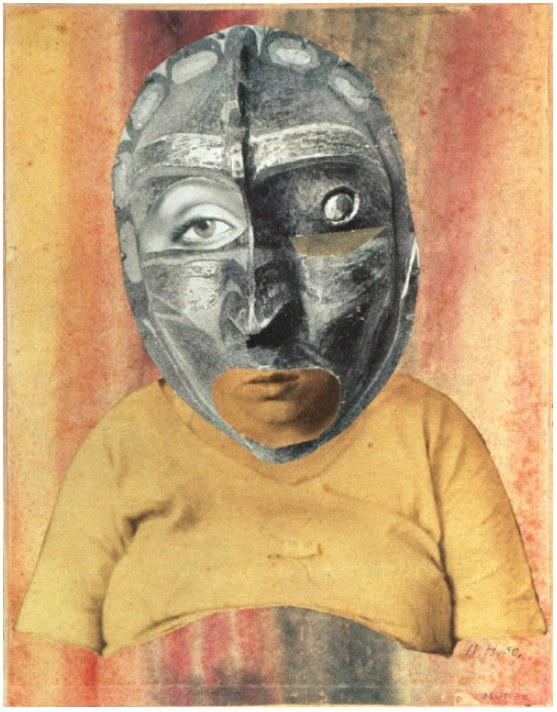
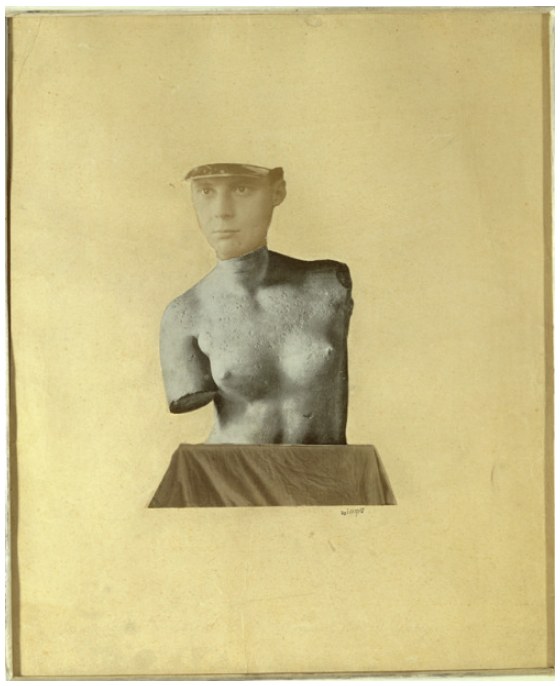 who judged the action as irrelevant to group survival).
who judged the action as irrelevant to group survival).
Perhaps I have belabored my point. Perhaps it is a point that anyone who reads this would not need emphasized in the first place. Isn’t it obvious to us that no art form is more about all these churning influences from untold visual decision makers — painters, printers, illustrators, photographers, designers — than the medium of collage itself? So, let us all continue to study the collage artworks of the explorers who came before us, to trace the direct lineage of their concepts and techniques, to recognize that valuable inheritance in the work of our peers, as well as in the composition taking shape on the surface before us, and then, fully informed, to push confidently into the second century of collage.
Tranquil Ode (to Merz)
collage homage by J A Dixon
9.5 x 11.875 inches
Purchase this artwork.
Make it count
Saturday, June 23rd, 2018“True desire in the heart, that itch that you have, whatever it is you want to do, that thing that you want to do to help others, and to grow, and to make money, that desire, that itch, that’s God’s proof to you, sent beforehand, to indicate that it’s yours already. And anything you want good you can have, so claim it, work hard to get it. When you get it, reach back, pull someone else up…”
— Denzel Washington
Denzel is the quintessence of the successful artist, and, by all appearances, he has defied the stereotype by cultivating humility and magnanimity. He also says, “Each one, teach one.” There are many ways to teach, and the opportunity presents itself differently at various points in our creative life.
I have always tried to compare and contrast the human qualities of those who have reached the pinnacle of an art form, and to remember that it cannot be about the creative result alone. When someone like Denzel advises, “Don’t just aspire to make a living. Aspire to make a difference.”, there is a desire for us to examine our definition of success, and it undoubtedly comes from his own life experience, one that’s had its ups and downs, its in-focus and out-of-focus moments.
For me, a passion for traditional teaching was more of a young person’s enterprise. I taught art to youngsters back in the “halcyon days” before background-check requirements, and spent seven years in my 30s as an adjunct professor in a university environment, taking what I was learning in the studio and sharing it with those just starting out. Other artists arrive at giving back much later in life, and bring to teaching their mature insights and proven practices. But, for me, the making of gift art has been the most fulfilling way to teach others in an unconventional way. Beyond a demonstration of willingness to give the gift of time and artistic effort instead of monetary value, one can also stimulate curiosity about the creative process that is personally powerful to young people.
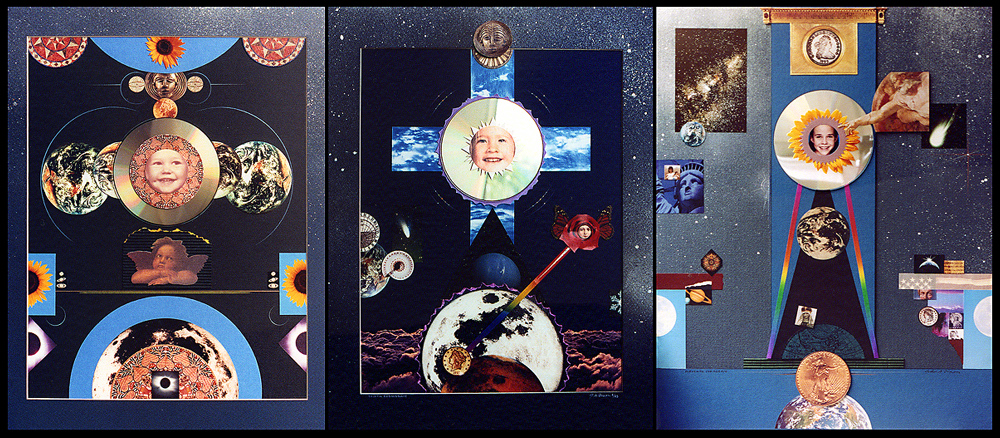
My Cosmosaic Series is only one of the ways that I have tried to meet this obligation. It is almost impossible to describe the reaction of young people when they realize that you’ve made them the object of an exercise in pure creativity, as well as the recipient of the finished work. Many profound conversations have been the result — discussions about life aspirations and individual destiny that would have been awkward or futile to jump-start in another context. It should go without saying that this is merely one way to teach another about one’s most significant values, but it happens to be one that is readily available to any imaginative individual.
As always, keep creating lots of stuff, but let’s not forget to make some of it count in an exceptional way. Pulling someone up a bit may be the most selfishly meaningful thing of all.
Thirteenth Cosmosaic
mixed media collage by J A Dixon
16 x 20 inches
private collection
Fourteenth Cosmosaic
mixed media collage by J A Dixon
16 x 20 inches
private collection
Sixteenth Cosmosaic
mixed media collage by J A Dixon
16 x 20 inches
private collection
Twenty-third Cosmosaic
mixed media collage by J A Dixon
16 x 20 inches
private collection
Top collage artists I never even knew about !!!
Saturday, January 13th, 2018“I have always tried to exploit the photograph. I use it like color, or as the poet uses the word.”
— Hannah Höch
It is always a temptation for a so-called blogger to dangle a “best of” or “top twenty” list to entice a visitor, and, of course, we see this tactic used almost on a daily basis in various fields of art and entertainment. How many of us have gone online and swallowed just such a colorful lure? On the most obvious level, the whole stimulus-response thing is a bit silly, but the potential to learn something new does exist, or to sharpen our own sense of quality, preference, and discernment. Each of us is free to have viewpoints, as long as we recognize them as personal opinions, and avoid casting them about as certitude. Isn’t there enough of that going on these days? (Yes, dear guest, that is merely my perspective.) 
What does this have to do with collage? Well, I just paid a visit to a page at AnotherMag.com (in response to the aforesaid bait), and I learned for the first time about three collage artists who were new to me, a working artist who purports to ruminate on “all things collage.” In this particular case, there may have been an explicit effort to achieve an overdue gender balance for a post intended to spotlight the Höch retrospective at the Whitechapel Gallery in London, but one could question the absence of Paolozzi, Rauschenberg, Johnson, Hamilton, or Kolář. To not include at least one of these men as a key figure in the history of collage brings no meaningful discredit on any of the artists, but only on the list. (And that, too, is just my opinion).
Nevertheless, I am not ashamed to accentuate the gaps in my collage literacy and to feature three noteworthy female artists: Eileen Agar, Nancy Spero, and Annegret Soltau. Examples of their work should have appeared here long before now.
Woman reading
by Eileen Agar, 1936
Museum of New Zealand
Protagonists
by Nancy Spero, 1989
disposition unknown
Grima – mit Katze
by Annegret Soltau, from her 1986-97 series
Vero Group Collection, Houston, Texas
The Surreal Face, Part Three
Sunday, February 26th, 2017“And the hits just keep on coming!”
— Bill Drake
Forgive my indulgence as I direct our attention once again to a favorite category of collage artwork. Followers of our medium at Instagram’s deep, mind-bending repository of visual imagery will confirm my declaration that The Surreal Face is 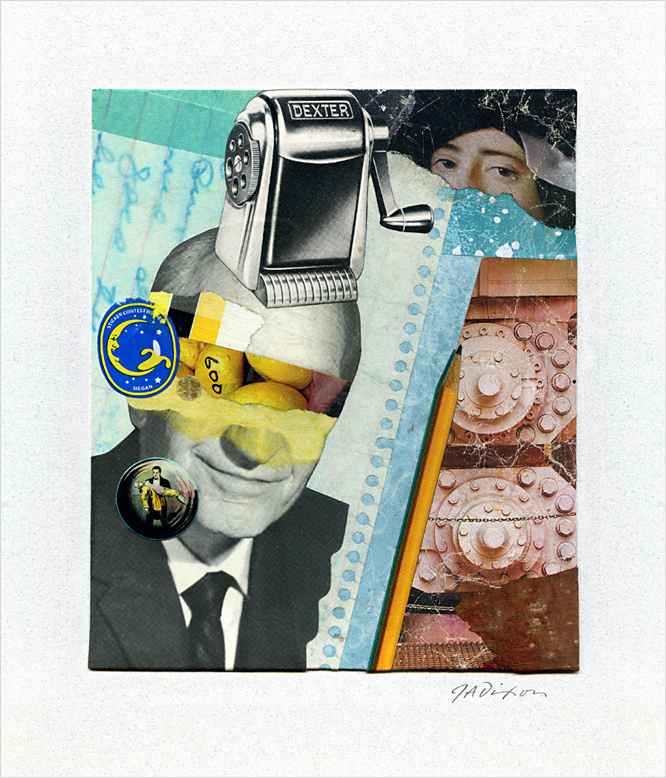 thriving in contemporary collage. I’m not the only person who likes to showcase fine solutions by others (which includes the anonymous sponsor of a page called Strange is Better). Call it a sub-genre or simply classify it under ‘21st-century Surrealism,’ it is a phenomenon that shows no symptoms of decline. Perhaps it goes without saying that something so accessible to entry-level collage artists is also an approach that is difficult to master. Julia Lillard’s devotion to the perennial subject demands that I single her out for a future review. Below are are a few examples that have recently caught my eye, and the links will provide a more extensive look at their bodies of work.
thriving in contemporary collage. I’m not the only person who likes to showcase fine solutions by others (which includes the anonymous sponsor of a page called Strange is Better). Call it a sub-genre or simply classify it under ‘21st-century Surrealism,’ it is a phenomenon that shows no symptoms of decline. Perhaps it goes without saying that something so accessible to entry-level collage artists is also an approach that is difficult to master. Julia Lillard’s devotion to the perennial subject demands that I single her out for a future review. Below are are a few examples that have recently caught my eye, and the links will provide a more extensive look at their bodies of work.
Kévin Ingrez
This so-called amateur collagist mines a rich vein of potential when it comes to the enduring genre of collage we continue to highlight.
Maja Egli
Her seamless blend of digital and handcrafted collage exemplify the vitality of ‘the Surreal Face’ theme.
Jaroslav Škojec
Although collage artwork by the Czech artist has not received wide exposure, his provocative images are shared regularly with Facebook users.
El Salto de Mendieta
A most intriguing artist, but I must admit that I cannot tell if this is an actual name or a pseudonym.
Øje Rum
The Danish artist’s long-running Silent Figure series is dedicated to the undeniable mystery of ‘the Surreal Face.’
Olivia Descampe
Juxtapositions by the Berlin-based artist are consistently bold, yet delicate, with no grim shadow to her surrealist approach.
Charles Wilkin
Wilkin’s distinctively undulating approach to surrealism is highly recognizable and always elegant.
Evan Clayton Horback
The Olympia-based artist frequently brings his signature mixed-media style to a structured treatment of ‘the Surreal Face.’
Jon Garbet
His colorful ideas are typically minimalist and characterized by a offbeat sense of humor.
The Surreal Face, Part Two
Friday, August 5th, 2016“If we adopt a surrealist viewpoint, art logically must be and naturally will tend to be surrealist, and thus be justifiable only in its ability to reveal the new, the ‘never seen,’ the parallel activity of thought and chance in consciousness.”
— Alan Gullette, 1979
You may recall, dear visitor, my June jaunt at this site into the staying power that “the surreal face” maintains in contemporary collage. I shall highlight a few more examples below. 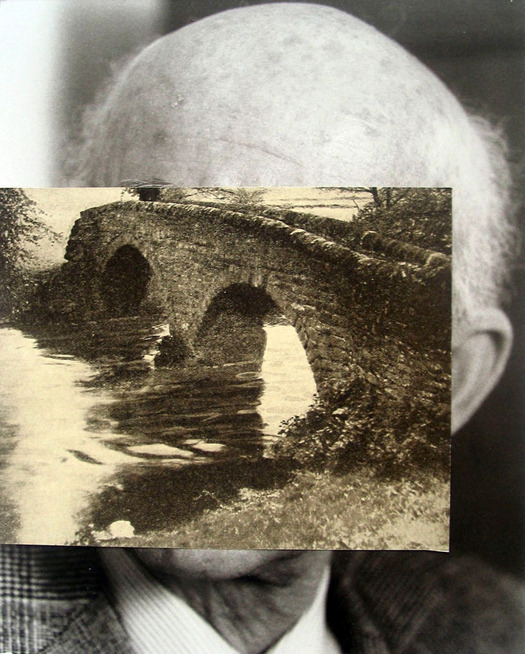 When a distinct sub-genre of the medium intrigues me, as this one clearly does, I often attempt to “diagram its visual pedigree” through the history of modern art. This is not an easy task for a non-academic (nor one, perhaps, for a scholar). A “collage geneologist” can run the risk of getting sidetracked into Man Ray or René Magritte, only to question whether use of the word “surreal” is relevant at all. Does it make more sense to trace a connection from Picasso to Tatlin to Hausmann’s 1920 homage to the Russian Constructivist and thereby leap-frog André Breton’s “psychic automatism” entirely? As much as I love the history of collage, all that delineation is beyond the scope of your humble Collage Miniaturist.
When a distinct sub-genre of the medium intrigues me, as this one clearly does, I often attempt to “diagram its visual pedigree” through the history of modern art. This is not an easy task for a non-academic (nor one, perhaps, for a scholar). A “collage geneologist” can run the risk of getting sidetracked into Man Ray or René Magritte, only to question whether use of the word “surreal” is relevant at all. Does it make more sense to trace a connection from Picasso to Tatlin to Hausmann’s 1920 homage to the Russian Constructivist and thereby leap-frog André Breton’s “psychic automatism” entirely? As much as I love the history of collage, all that delineation is beyond the scope of your humble Collage Miniaturist. 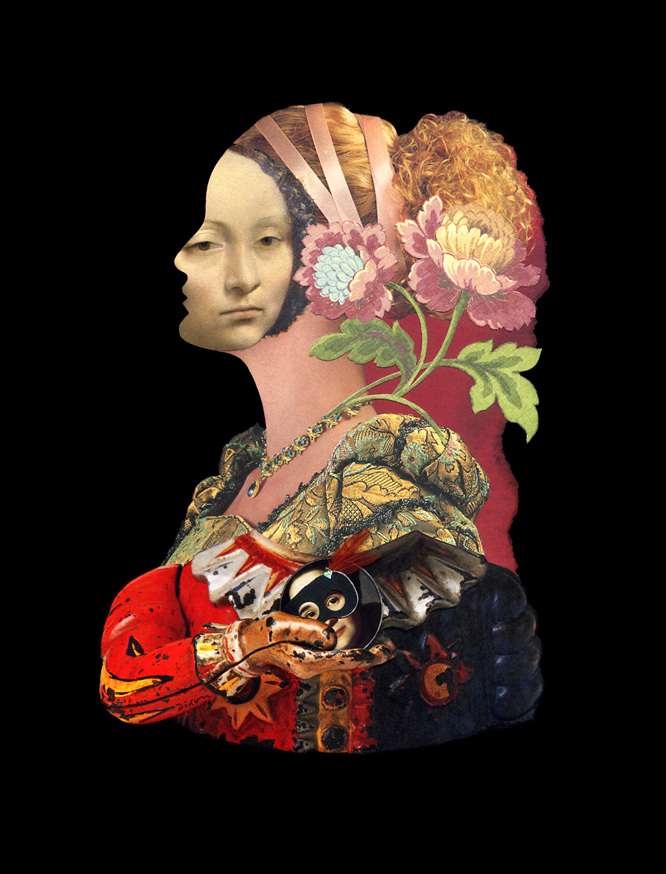
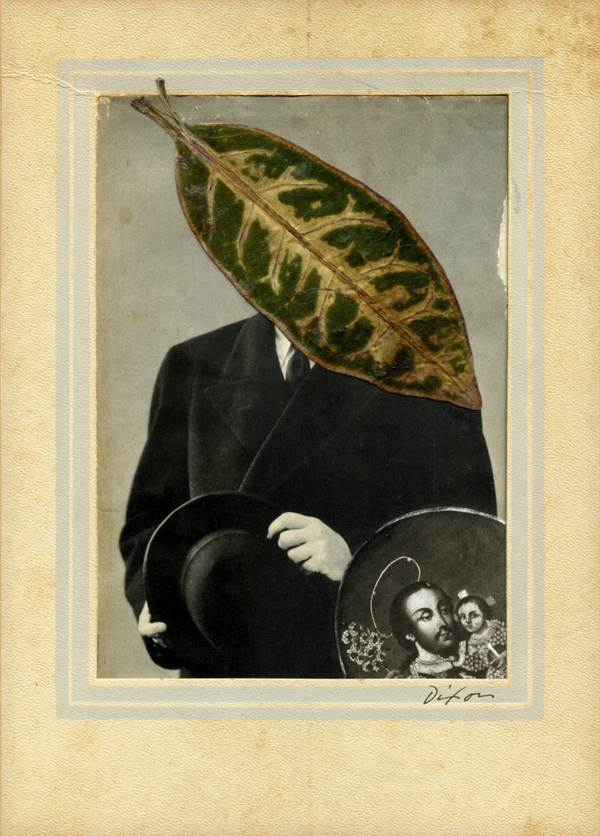 Suffice it to say that the gongs of Dada still reverberate. Ultimately, we are more concerned with a phenomenon that is alive and well among contemporary collage artists (and that long ago shed any musty trappings of Weimar Republic protest, Trotskyite dilettantism, or hostility toward religion). Even a cursory review of recent collage output exposes an enduring thread weaving its way through students, emerging professionals, veteran practitioners, and masters of the medium. Rather than muddy ourselves grubbing 20th-century roots, let us instead ask two important questions — What is the elusive essence of “the surreal face,” and why does its enduring appeal lack any sign of a downtrend?
Suffice it to say that the gongs of Dada still reverberate. Ultimately, we are more concerned with a phenomenon that is alive and well among contemporary collage artists (and that long ago shed any musty trappings of Weimar Republic protest, Trotskyite dilettantism, or hostility toward religion). Even a cursory review of recent collage output exposes an enduring thread weaving its way through students, emerging professionals, veteran practitioners, and masters of the medium. Rather than muddy ourselves grubbing 20th-century roots, let us instead ask two important questions — What is the elusive essence of “the surreal face,” and why does its enduring appeal lack any sign of a downtrend?
Isabel Reitemeyer
Her consummate approach convinces me that less indeed can be more.
Robert Hugh Hunt
Fresh, intuitive, culturally aware. Robbo’s art springs from individuality.
Manu Duf
There is never a timid thing about his proficient approach to collage.
Eduardo Recife
The Brazilian illustrator sets a high standard for digital collage.
Erin Case
The Michigan-based artist is rapidly making her mark as a collage pro.
Claudia Pomowski
The versatile graphic artist is a “collage experimentalist.”
Jordana Mirski Fridman
This emerging designer/artist is “exploding” onto the medium.
Julia Lillard
The self-taught Oklahoma artist has nailed “the surreal face.”
Various and Sundry — Four Years and Counting . . .
Friday, July 29th, 2016“I write because I don’t know what I think until I read what I say.”
— Flannery O’Connor
It looks as though I’m stepping into my fifth year writing about collage at this blogsite, and I hope that you’ve been with me for part of that enjoyable ride.
When I look back at my wish list for Year Four, I realize, not with any surprise, that my appetite for creating collage artwork has eclipsed a sometimes equally strong desire to delve verbally into the many interesting aspects of the medium. I would like to think that I met a few of the writing goals I set for myself last summer, and, of course, my ambitions to add to that list here in this post will be dutifully curbed. At any rate, I think that the best thing to do is to break this entry into a few parts that cover various and sundry topics on my mind.
The Social Network of Collage Artists
• For at least a couple of years I have wanted to write more about the influence of social media. Nearly every day I see a collage artist defeat the potential of a sharing platform with overexposure. Some may disagree and say, “the more, the merrier.”  That is not a point I care to debate, because there may be something else to highlight more important than whether or not the quality-vs-quantity consideration can fall to the wayside — the vital role of networking among artists. I am more convinced than ever that the cross-pollination and mutual support of online networks has been of significant benefit to those of us working in the medium. Crystal Neubauer has one of the more interesting blogsites by a collage artist. She touched on the topic of creative communities so well that I direct you to her short essay at ClothPaperScissors.com. Another collage artist I admire who has recently made an impression as a strong blogger is Melinda Tidwell. I like her process-oriented posts. Although more of a mixed-media artist rather than a conventional collage practitioner, the versatile Kathleen O‘Brien maintains a steady flow of what I consider “must-read” entries at her studio blogsite. Create your own list of frequent art-blog destinations and branch out to new sharing platforms (I just learned about some new artist blogs from Caterina Giglio and opened a new account at Instagram.). As the entire evolving array of networking sites weeds out the fads, imitators and clunky interfaces (finding it difficult to tolerate LinkedIn as a user), you will settle into a community of online cohorts who reinforce your daily challenges as a creative person. When you come to know that someone else is on “the same wavelength,” reach out and make contact as an authentic being behind the profile. There are rewards to be discovered!
That is not a point I care to debate, because there may be something else to highlight more important than whether or not the quality-vs-quantity consideration can fall to the wayside — the vital role of networking among artists. I am more convinced than ever that the cross-pollination and mutual support of online networks has been of significant benefit to those of us working in the medium. Crystal Neubauer has one of the more interesting blogsites by a collage artist. She touched on the topic of creative communities so well that I direct you to her short essay at ClothPaperScissors.com. Another collage artist I admire who has recently made an impression as a strong blogger is Melinda Tidwell. I like her process-oriented posts. Although more of a mixed-media artist rather than a conventional collage practitioner, the versatile Kathleen O‘Brien maintains a steady flow of what I consider “must-read” entries at her studio blogsite. Create your own list of frequent art-blog destinations and branch out to new sharing platforms (I just learned about some new artist blogs from Caterina Giglio and opened a new account at Instagram.). As the entire evolving array of networking sites weeds out the fads, imitators and clunky interfaces (finding it difficult to tolerate LinkedIn as a user), you will settle into a community of online cohorts who reinforce your daily challenges as a creative person. When you come to know that someone else is on “the same wavelength,” reach out and make contact as an authentic being behind the profile. There are rewards to be discovered!
Cheap Collage Tricks
• Collage artist Allan Bealy seems to be everywhere, but, trust me, he is no gadfly. He recently raised a topic that struck a nerve with many. There are a lot of cheap tricks appearing in the medium, and most of them are harmless, if unimaginative, but the temptation to exploit visual ingredients readily available in our culture to “objectify women” is perhaps the most repugnant.  Those of us who believe we are above that sort of thing need to think more deeply about how and why we use nudes in a collage. This suggests another potential self-assignment for my coming year — a “DON’T DO THIS” post illustrating the most prevalent cheap tricks in collage. (Not that there’s anything wrong with replacing a man’s head with a vulture to carry the banner of Dada during the art movement’s centennial year.) To be honest, I have nothing against a cliche, if it “works.” Isn’t that the reason something becomes a cliche in the first place? I say go for the cheap trick if you can score in the highest percentile (anyone who thinks it’s an easy thing to do is mistaken). I hope to post a follow-up look at the endurance of the surreal face in collage, so stay tuned. But let’s get back to Allan’s remonstrance. The woman as sex object can be traced back to long before the rise of Madison Avenue and Larry Flynt. Don’t bite the lure, folks. Everything one needs to dabble in this unworthy stunt abounds. Nevertheless, I long have been fascinated with the exemplars of erotic minimalism and their work in contemporary collage — those who transcend the cheap tricks to achieve a fine-art impression. Add another one to my wish list for Year Five of The Collage Miniaturist.
Those of us who believe we are above that sort of thing need to think more deeply about how and why we use nudes in a collage. This suggests another potential self-assignment for my coming year — a “DON’T DO THIS” post illustrating the most prevalent cheap tricks in collage. (Not that there’s anything wrong with replacing a man’s head with a vulture to carry the banner of Dada during the art movement’s centennial year.) To be honest, I have nothing against a cliche, if it “works.” Isn’t that the reason something becomes a cliche in the first place? I say go for the cheap trick if you can score in the highest percentile (anyone who thinks it’s an easy thing to do is mistaken). I hope to post a follow-up look at the endurance of the surreal face in collage, so stay tuned. But let’s get back to Allan’s remonstrance. The woman as sex object can be traced back to long before the rise of Madison Avenue and Larry Flynt. Don’t bite the lure, folks. Everything one needs to dabble in this unworthy stunt abounds. Nevertheless, I long have been fascinated with the exemplars of erotic minimalism and their work in contemporary collage — those who transcend the cheap tricks to achieve a fine-art impression. Add another one to my wish list for Year Five of The Collage Miniaturist.
Priorities Get the Last Word
• My wife, Dana, and I managed to get two tickets to The Seer (a new documentary portrait of Kentuckian Wendell Berry, re-titled “Look & See” for Sundance Institute) before the Lexington screening sold out last night. 
 It is a significant film that will become more widely available into next year, and it has my highest recommendation. Does it have anything to do with collage? Nothing at all, except for everything under the sun. If you haven’t discovered the poet, novelist, essayist, and farmer-philosopher, I have accomplished one meaningful thing with this site by inviting your interest. It was fitting that I got out of the studio and spent time at our farm. It was very hot work up on the shed roof, but pleasant to be away from all the noise (traffic, sirens, and incessant political jousting). Connecting with our rural place offered an opportunity, as it always does, to put priorities back into alignment. There is a place in the documentary when Laura Dunn (the filmmaker in voice-over) explains to Berry her motivation and how she looks “to places where there is still a remnant of togetherness, or unity, or community, of connection to the land, and I study those, because I don’t come from a place — I come from divorce …”
It is a significant film that will become more widely available into next year, and it has my highest recommendation. Does it have anything to do with collage? Nothing at all, except for everything under the sun. If you haven’t discovered the poet, novelist, essayist, and farmer-philosopher, I have accomplished one meaningful thing with this site by inviting your interest. It was fitting that I got out of the studio and spent time at our farm. It was very hot work up on the shed roof, but pleasant to be away from all the noise (traffic, sirens, and incessant political jousting). Connecting with our rural place offered an opportunity, as it always does, to put priorities back into alignment. There is a place in the documentary when Laura Dunn (the filmmaker in voice-over) explains to Berry her motivation and how she looks “to places where there is still a remnant of togetherness, or unity, or community, of connection to the land, and I study those, because I don’t come from a place — I come from divorce …”
“We all come from divorce!” her subject interrupts. “This is an age of divorce. Things that belong together have been taken apart. And you can’t put it all back together again. What you can do, is the only thing that you can do. You take two things that ought to be together and you put them together. Two things! Not all things.” It is his metaphor for the creative life, and a tremendously healing admonition to those of us with a tendency to become overwhelmed by the enormity of the world’s chaotic disintegration. Collage artists put things together to make something new, and often we are the ones who have taken apart discarded things to do it, but there is always a much larger phenomenon at work — one of discord vs harmony, wastefulness vs thrift, cynicism vs affection. When I return to the studio from a natural place that has responded to my care, I am in a better condition to ask myself, “To which side of the big equation are you making your contribution as an artist?”
Crystal Neubauer
Her blogging often touches on the complexity of a creative life.
Melinda Tidwell
Perhaps you will admire her solid abstractions as much as I do.
Kathleen O’Brien
Her art always nudges one toward a deeper sense of balance and wholeness.
Robert Hugh Hunt
Stay tuned for a continuation of my review of “the surreal face.”
Bene Rohlmann
Look ahead to my first discussion of erotic minimalism in collage.
